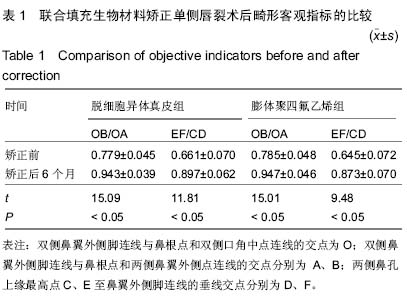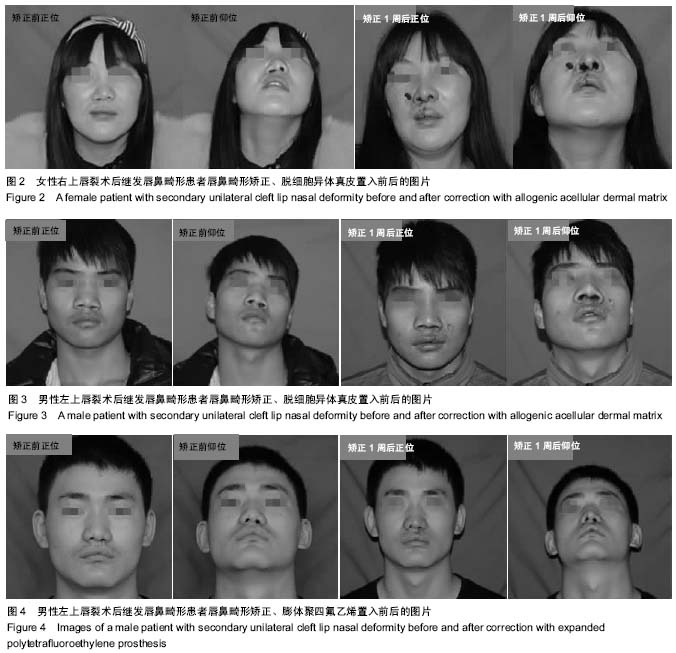| [1] 王炜.整形外科学[M].杭州:浙江科学技术出版社,1999:644-697.
[2] Kalaskar R,Kalaskar A,Naqvi FS,et al. Prevalence and evaluation of environmental risk factors associated with cleft lip and palate in a central Indian population.Pediatr Dent.2013; 35(3):279-283.
[3] Fisher DM,Lo LJ,Chen YR,et al.Three-dimensional computed tomographic analysis of the primary nasal deformity in 3-month—old infants with complete unilateral cleft lip and palate.Plast Reconstr Surg.1999;103(7):1826-1834.
[4] 朱光辉,庞晓刚.单侧唇裂鼻畸形矫正的临床进展[J].中国美容医学,2013,22(15):1651-1653.
[5] 付茂东,刁成山,李成华,等.单侧唇裂继发鼻畸形整复的临床研究[J].中国美容医学,2014,23(17):1438-1440.
[6] Fisher MD,Fisher DM,Marcus JR.Correction of the Cleft Nasal Deformity. Clin Plast Surg.2014;41(2):283-299.
[7] 潘葵,陈兵.利用鼻底双旋转皮瓣修复单侧唇裂继发鼻底畸形[J].中国美容医学,2012, 21(6):915-916.
[8] Byrd HS, El-Musa KA, Yazdani A.Definitive repair of the unilateral cleft lip nasal deformity.Plast Reconstr Surg.2007; 120(5):1348-1356.
[9] 施泽宏,李平松,周羽.鼻侧Medpor假体置入矫正单侧唇裂术后患侧上颌骨发育不足[J].中国美容医学,2011,20(12):1884-1886.
[10] Lee HY,Yang HJ, Rhie JW,et al. Adipose Tissue Regeneration In Vivo Using Micronized Acellular Allogenic Dermis as an Injectable Scaffold.Aesthetic Plast Surg. 2014;38(5): 1001-1010.
[11] 罗志军,黎洪棉,王和庚,等.脱细胞异体真皮基质与人脂肪干细胞的生物相容性[J].中国组织工程研究,2012,16(25):4616-4621.
[12] 杨建民,王配合,李建全,等.脱细胞异体真皮和自体刃厚皮复合移植在功能部位深度烧伤中的应用[J].解放军医药杂志,2014, 26(5):45-47,50.
[13] 张琼阁,王喜梅,郭丽丽,等.硅胶假体及脱细胞真皮辅助女性Poland综合征患者的乳房再造[J].中国组织工程研究,2014, 18(21):3425-3430.
[14] 徐祥,吕大伦.脱细胞真皮基质临床研究及应用进展[J].临床医学工程,2014,21(3):396-398.
[15] 殷艳丽,王倩婷,赵蕾.脱细胞真皮基质用于牙周病学领域研究进展[J].中国实用口腔科杂志,2014,7(7):434-439.
[16] 王健诚,王炜,张科,等邹世镇.脱细胞异体真皮基质填塞修复高位肛瘘[J].中国组织工程研究,2014,18(34):5497-5502.
[17] 邹永红,高山,田方兴,等.自体耳软骨联合膨体聚四氟乙烯矫正短鼻畸形[J].中国美容医学,2013,22(24):2345-2347.
[18] 付德林,薛轶群,李丹阳. EPTFE隆鼻与耳软骨移植做支架纠正鼻背低平伴鼻头肥大低垂[J]. 中国美容医学,2012,21(7): 1143-1145.
[19] Carter PR,LeBlanc KA,Hausmann MG,et al.Does expanded polytetrafluoroethylene mesh really shrink after laparoscopic ventral hernia repair?Hernia.2012;16(3):321-325.
[20] 缪冬华.四种隆鼻材料在临床应用中的生物学性能比较[J].中国医疗美容,2014,5(1):42-45.
[21] 李俊,杨涛,周蓓,等.膨体聚四氟乙烯与固体硅胶隆鼻术后肿胀的临床分析比较[J].中国美容医学,2014,23(10):801-804.
[22] 王涛. 单侧完全性唇裂同期鼻整形联合鼻撑矫形效果的评价研究[D].第四军医大学,2012.
[23] 张力平,孙家和,管宇,等.改良Bardach法矫治单侧唇裂术后鼻畸形远期效果分析[J].中华医学美容杂志,1999,1(5):7-9.
[24] 杨小平.唇裂术后继发畸形的分类及治疗原则[J].中华口腔医学研究杂志(电子版),2013,7(4):261-264.
[25] 史劲松,陈伟.不同手术方法修复单侧完全性唇裂的临床分析[J].口腔颌面外科杂志,2013,23(3):209-211.
[26] Rossell-Perry P,Romero-Narvaez C.Evaluation of the use of auricular composite graft for secondary unilateral cleft lip nasal alar deformity repair.Plast Surg Int. 2014;2014:270285.
[27] 肖文芝,刘华,陈涌,等.单侧唇裂继发鼻畸形的临床整复[J].中国美容医学, 2014,23(3):183-186.
[28] 谢娟,赵宇,曹东升.软骨重建在单侧唇裂术后鼻畸形修复中的应用[J].组织工程与重建外科杂志,2014,10(3):161-163.
[29] 仝润泽,吕启凤,厉建华,等. e-PTFE在唇裂术后继发鼻畸形修复中的拓展应用[J].中国美容医学,2014,22(2):93-96.
[30] Narasimhan S, Aslam S, Lin PH,et al.Bacterial translocation across ePTFE vascular graft surfaces.J Infect. 2010;60(6): 486-490.
[31] Cohen M, Morris DE, White AD, et al.Functional and aesthetic correction of secondary unilateral cleft lip nasal deformities. Indian J Plast Surg.2009;42 Suppl:S91-S101. |


.jpg)